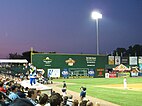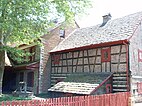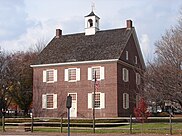
Back يورك (بنسيلفانيا) Arabic یورک، پنسیلوانیا AZB York (Pennsylvania) Breton Йорк (Пенсильвани) CE York (kapital sa kondado sa Tinipong Bansa, Pennsylvania) CEB York, Pennsylvania Welsh York (Pennsylvania) German York (Pensilvanio) Esperanto York (Pensilvania) Spanish York (Pennsylvania) Basque
York | |
|---|---|
| Nickname: The White Rose City | |
 Location of York in York County, Pennsylvania. | |
| Coordinates: 39°57′46″N 76°43′41″W / 39.96278°N 76.72806°W | |
| Country | |
| State | |
| County | York |
| Laid out | 1741 |
| – Borough | September 24, 1787 |
| – City | January 11, 1887 |
| Government | |
| • Mayor | Michael Helfrich (D)[1] |
| Area | |
| • City | 5.34 sq mi (13.84 km2) |
| • Land | 5.29 sq mi (13.71 km2) |
| • Water | 0.05 sq mi (0.13 km2) |
| Elevation | 367 ft (112 m) |
| Population (2020) | |
| • City | 44,800 |
| • Density | 8,389.5/sq mi (3,237.0/km2) |
| • Urban | 238,549 (US: 168th)[3] |
| • Urban density | 2,109.6/sq mi (814.5/km2) |
| • Metro | 456,438 (US: 121st) |
| Time zone | UTC−5 (EST) |
| • Summer (DST) | UTC−4 (EDT) |
| ZIP Codes | 17401, 17403–17405 |
| Area code(s) | 717 and 223 |
| FIPS code | 42-87048 |
| GNIS feature ID | 1215771[4] |
| Website | www |
York is a city in and the county seat of York County, Pennsylvania, United States.[5] Located in South Central Pennsylvania, the city's population was 44,800 at the time of the 2020 census, making it the tenth-most populous city in Pennsylvania.[6] The city has an urban area population of 238,549 people and a metropolitan population of 456,438 people.
Founded in 1741, York served as the temporary base for the Continental Congress from September 1777 to June 1778, during which the Articles of Confederation were drafted. It is the largest city in the York–Hanover metropolitan area, which is also included in the larger Harrisburg–York–Lebanon combined statistical area of the Susquehanna Valley.
- ^ Albring, Angel (November 2, 2021). "Election 2021 results: York Mayor Michael Helfrich re-elected, longtime district judge loses". York Daily Record. Retrieved April 1, 2024.
- ^ "2019 U.S. Gazetteer Files". United States Census Bureau. Retrieved July 28, 2020.
- ^ "List of 2020 Census Urban Areas". census.gov. United States Census Bureau. Retrieved January 7, 2023.
- ^ a b U.S. Geological Survey Geographic Names Information System: York, Pennsylvania
- ^ "Find a County". National Association of Counties. Retrieved July 2, 2016.
- ^ Boehm, Eric (March 24, 2015). "Nine of Pennsylvania's 10 largest cities have more pensioners than workers". watchdog.org. Franklin Center for Government & Public Integrity. Archived from the original on January 10, 2016. Retrieved June 5, 2015.
York, which is the state's 11th largest city by population...









